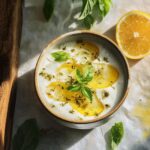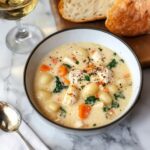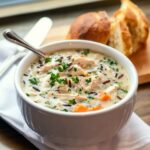Cavacas are traditional Portuguese pastries resembling popovers. They have a light and airy texture, complemented by a sweet, lemon-infused glaze. These delightful treats are perfect for dessert or a sweet snack.
Full Recipe:
Ingredients
-
2 cups all-purpose flour
-
1 cup canola or vegetable oil
-
1/2 cup whole milk
-
8 large eggs, at room temperature
For the Sugar Glaze:
-
2 cups confectioners’ sugar
-
Zest of one lemon
-
Approximately 2 tablespoons milk
Directions
-
Preheat the oven to 350°F (175°C).
-
Grease standard-size muffin tins or popover pans.
-
In a stand mixer, combine the flour, oil, milk, and eggs. Beat on medium speed for at least 20 minutes without interruption.
-
Fill the prepared tins no more than halfway with the batter.
-
Bake on the middle rack for about 45 minutes for moist cavacas or up to 1 hour for a drier texture.
-
While the cavacas are baking, prepare the glaze by mixing the confectioners’ sugar, lemon zest, and enough milk to achieve a smooth consistency.
-
Once baked, while still warm, spoon the glaze over each cavaca or dip them directly into the glaze.
-
For optimal taste and texture, serve the cavacas on the same day they are made, as they tend to dry out quickly.
Nutrients (Per Serving, based on 12 servings)
-
Calories: Approximately 310 kcal
-
Total Fat: 18g
-
Saturated Fat: 2.5g
-
Cholesterol: 125mg
-
Sodium: 60mg
-
Total Carbohydrates: 32g
-
Sugars: 20g
-
Protein: 5g
Historical Background
The origins of cavacas are deeply rooted in Portugal’s monastic traditions. During the 15th and 16th centuries, convents and monasteries played a pivotal role in the development of Portuguese confectionery. Nuns and monks, utilizing the abundant egg yolks left over from using egg whites for starching clothes and clarifying wines, crafted numerous sweet delicacies. Cavacas emerged from this era, showcasing the resourcefulness and culinary artistry of these religious communities.
One notable variation is the Cavacas de Resende, originating from the municipality of Resende. These are distinguished by their unique preparation method, involving a double glazing process that enhances their sweetness and texture. The batter, made from farm-fresh eggs, flour, and sugar, is baked, sliced, and then coated with two types of sugar syrups, resulting in a delectable confection that has become synonymous with the region. In the city of Aveiro, cavacas take on a cultural significance during the annual Festas de São Gonçalinho. During this festival, thousands of cavacas are thrown from the top of the Chapel of São Gonçalinho, symbolizing the fulfillment of promises and the community’s devotion to the saint. This tradition not only underscores the pastry’s deep-rooted presence in Portuguese culture but also highlights the communal spirit that surrounds its consumption.
Cultural Significance
Cavacas are more than just a sweet treat; they embody the essence of Portuguese hospitality and tradition. Often served during celebrations such as weddings, baptisms, and religious festivals, these pastries symbolize joy and togetherness. Their presence at such events underscores the importance of sharing and community in Portuguese culture.
The act of preparing cavacas is often a communal endeavor, with family members gathering in the kitchen to mix, bake, and glaze the pastries. This collective effort not only strengthens familial bonds but also ensures the preservation of the recipe and its associated traditions for future generations.
Regional Variations
While the core ingredients of cavacas remain consistent—flour, eggs, oil, and sugar—regional variations have emerged over time, each adding a unique twist to the classic recipe.
-
Cavacas das Caldas: Hailing from Caldas da Rainha, these cavacas are renowned for their crisp texture and are often enjoyed alongside a cup of coffee or tea. The pastries are typically larger and feature a generous coating of sugar glaze, adding to their sweetness and appeal.
-
Cavacas de Resende: As previously mentioned, this variation involves a distinctive double glazing process, resulting in a pastry that is both crunchy and sweet. The meticulous preparation method reflects the region’s dedication to preserving its culinary heritage.
-
Cavacas de Coimbra: In Coimbra, cavacas are often smaller and may incorporate a hint of vanilla or other flavorings, showcasing the adaptability of the recipe to local tastes and preferences.
Modern Interpretations
In contemporary culinary landscapes, cavacas have experienced a resurgence, with chefs and home bakers experimenting with innovative flavors and presentations. Some modern interpretations include:
-
Chocolate-Dipped Cavacas: Adding a layer of rich chocolate to the traditional glaze introduces a decadent twist, appealing to chocolate enthusiasts.
-
Filled Cavacas: Incorporating fillings such as custard, fruit preserves, or whipped cream adds complexity and enhances the pastry’s flavor profile.
-
Mini Cavacas: Creating bite-sized versions caters to contemporary preferences for smaller, more manageable portions, making them ideal for events and gatherings.
These modern takes not only pay homage to the traditional recipe but also demonstrate the versatility and enduring appeal of cavacas in the evolving world of pastry arts.
Serving Suggestions
Cavacas are versatile pastries that can be enjoyed in various settings and pairings. Here are some popular ways to savor them:
-
With Beverages: Their light and airy texture makes cavacas an ideal accompaniment to coffee, tea, or even a glass of Port wine. The sweetness of the glaze complements the bitterness of coffee, creating a balanced flavor experience.
-
Dessert Platters: In Portugal, it’s common to serve an assortment of traditional pastries during celebrations. Including cavacas alongside other treats like pastéis de nata (custard tarts) and queijadas (cheese pastries) offers guests a delightful variety of flavors and textures.
-
Filled Cavacas: For a decadent twist, some variations involve filling the pastries with whipped cream, lemon curd, or chocolate ganache. This addition enhances the flavor profile and adds a creamy contrast to the crisp exterior.
Nutritional Considerations
While cavacas are undeniably delicious, it’s essential to be mindful of their nutritional content, especially for those monitoring their dietary intake. As a pastry rich in eggs and sugar, they are relatively high in calories and carbohydrates. However, their small size allows for portion control, making it possible to indulge in moderation without significant dietary impact.
For those with dietary restrictions, exploring alternative ingredients—such as using gluten-free flour blends or sugar substitutes—can make cavacas more accessible without compromising their traditional essence.
Conclusion
Cavacas stand as a testament to Portugal’s rich culinary heritage, embodying the country’s penchant for simple yet profoundly flavorful confections. Their enduring presence in Portuguese culture, from festive celebrations to everyday indulgences, speaks to their universal appeal and the joy they bring to those who partake.






